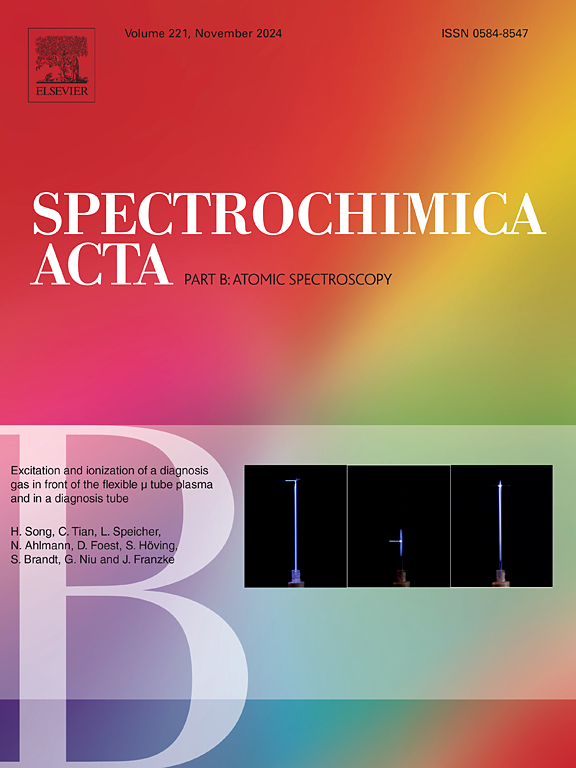Femtosecond Laser-Induced Ablation – Quadrupole Mass Spectrometry (fs-LIA-QMS) experiment for the detection of trapped hydrogen isotopes and helium in nuclear fusion relevant materials
IF 3.8
2区 化学
Q1 SPECTROSCOPY
引用次数: 0
Abstract
We present a novel instrumentation using ultrashort pulsed laser induced ablation in combination with a Quadrupole Mass Spectrometer (QMS) for the detection of gaseous species retained in tungsten (W) and other metallic substrates. In particular, the potential of this technique for the investigation of hydrogen isotopes retention in plasma-facing components of fusion devices is demonstrated. Our fs-LIA-QMS experiment is capable of detecting deuterium (D) and helium (He) in W samples with high sensitivity down to , depth resolution in the order of , and high lateral resolution better than . The study highlights the importance of using sub-picosecond laser pulses for an accurate depth-resolved detection of gaseous species trapped in metallic substrates. The use of ultra-short, near UV laser pulses () reduces heat affection compared with nanosecond and picosecond ablation processes. Our results are in good agreement with other diagnostics applied in this context, such as 3-He Nuclear Reaction Analysis (NRA) for the D depth profiling, and numerical simulations of the He distribution with SDTrimSP. We also discuss the limitations of the technique, including the influence of heat diffusion initiated by the fs-laser and the characterization of loss-channels in the system that determine the limit of detection.

飞秒激光诱导烧蚀-四极杆质谱(fs-LIA-QMS)实验,用于检测核聚变相关材料中捕获的氢同位素和氦
我们提出了一种使用超短脉冲激光诱导烧蚀与四极杆质谱仪(QMS)相结合的新型仪器,用于检测保留在钨(W)和其他金属衬底中的气态物质。特别是,这项技术的潜力,以研究氢同位素保留在聚变装置的等离子体面向组件。我们的fs-LIA-QMS实验能够检测W样品中的氘(D)和氦(He),灵敏度低至0.005at。%,深度分辨率在15nm/脉冲量级,高横向分辨率优于30μm。该研究强调了使用亚皮秒激光脉冲对金属衬底中捕获的气体进行精确深度分辨检测的重要性。与纳秒和皮秒烧蚀工艺相比,使用超短、近紫外激光脉冲(400fs,343nm)减少了热影响。我们的结果与其他在此背景下应用的诊断方法非常一致,例如用于D深度剖面的3-He核反应分析(NRA),以及使用SDTrimSP对He分布的数值模拟。我们还讨论了该技术的局限性,包括由fs激光引发的热扩散的影响以及决定检测极限的系统中损耗通道的表征。
本文章由计算机程序翻译,如有差异,请以英文原文为准。
求助全文
约1分钟内获得全文
求助全文
来源期刊
CiteScore
6.10
自引率
12.10%
发文量
173
审稿时长
81 days
期刊介绍:
Spectrochimica Acta Part B: Atomic Spectroscopy, is intended for the rapid publication of both original work and reviews in the following fields:
Atomic Emission (AES), Atomic Absorption (AAS) and Atomic Fluorescence (AFS) spectroscopy;
Mass Spectrometry (MS) for inorganic analysis covering Spark Source (SS-MS), Inductively Coupled Plasma (ICP-MS), Glow Discharge (GD-MS), and Secondary Ion Mass Spectrometry (SIMS).
Laser induced atomic spectroscopy for inorganic analysis, including non-linear optical laser spectroscopy, covering Laser Enhanced Ionization (LEI), Laser Induced Fluorescence (LIF), Resonance Ionization Spectroscopy (RIS) and Resonance Ionization Mass Spectrometry (RIMS); Laser Induced Breakdown Spectroscopy (LIBS); Cavity Ringdown Spectroscopy (CRDS), Laser Ablation Inductively Coupled Plasma Atomic Emission Spectroscopy (LA-ICP-AES) and Laser Ablation Inductively Coupled Plasma Mass Spectrometry (LA-ICP-MS).
X-ray spectrometry, X-ray Optics and Microanalysis, including X-ray fluorescence spectrometry (XRF) and related techniques, in particular Total-reflection X-ray Fluorescence Spectrometry (TXRF), and Synchrotron Radiation-excited Total reflection XRF (SR-TXRF).
Manuscripts dealing with (i) fundamentals, (ii) methodology development, (iii)instrumentation, and (iv) applications, can be submitted for publication.

 求助内容:
求助内容: 应助结果提醒方式:
应助结果提醒方式:


